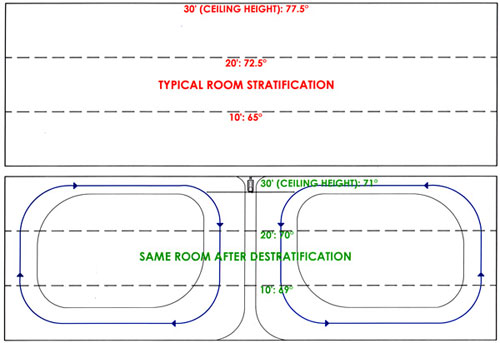HVAC for Large Spaces: The Sustainable Benefits of HVLS (High Volume/Low Speed) Fans
HVLS fans provide superior benefits in many situations:
• For hot months in facilities without air conditioning. Slowly moving air at three to five miles per hour breaks up the moisture-saturated boundary layer surrounding the body; this accelerates evaporation to produce a cooling effect.
• Where an excessive amount of heat has risen and become trapped near the ceiling. Trapped heat stagnates and interferes with proper ventilation. HVLS fans circulate the trapped heat, continually forcing it to circulate down and throughout the structure without creating an uncomfortable windy effect.
• In un-insulated buildings and those with large open doors and/or open-sides.
• For operations which produce smoke or fumes requiring continuous ventilation, such as welding and fabrication, metal casting and forging, or painting and finishing.
• In large, sparsely populated warehouses where air-conditioning would be wasteful.
• Where the dehydrating effect of air-conditioning is undesirable, for example, in commercial bakeries, operations requiring the application of chemicals, or produce handling/packing operations.
• Where the installation of air-conditioning would disrupt operations.
For example, renovations in large factories where existing machinery will not be removed, or shipping/receiving operations where conveyor systems would interfere with installing ducting.
• Anywhere the costs of air-conditioning are prohibitive or irrecoverable.
For instance, aircraft hangars or facilities over 500,000 sq ft.
• For even-air distribution in buildings with conventional evaporative coolers.
Higher horsepower HVLS fans.1½ or 2 HP, often fitted with six blades, 20-ft to 24-ft in diameter, are an efficient and cost-effective alternative when higher velocities are required or where extreme moisture, bacteria, mold, mildew, and wet conditions, such as wet floors, exist in, for example, food processing plants.
Adding HVAC.Under moderate heat conditions, industrial-size HVLS fans can be run without air conditioning, which reduces energy consumption and cuts operating costs while still producing a pleasant open-air environment. However, they can also be used with more traditional HVAC systems, new or existing, to increase the efficiency of the overall system.
• On hot days, since slow-moving air produces a cooling effect, they can be run with the air-conditioning thermostat set 10 degrees to 15 degrees warmer for equivalent cooling effect (See Chart For 24 Foot Diameter 2 Hp 6 Blade Fan on page 1).
• Due to better air mixing, HVLS fans provide adequate ventilation while requiring less cooled air to be replaced with hot air from outside.
• In a system designed around HVLS fans, cool air distribution costs will consequently be reduced.
• In new construction, the cost of the industrial fans may be completely offset by the elimination of expensive ducting and the reduction in required air-conditioning capacity.
Heating
Cutting heating costs with HVLS fans. In most commercial and industrial buildings heaters are mounted overhead so as to not interfere with working space. Unfortunately, this results in a heat gradient differential or heat stratification of 10 degrees F to 35 degrees F from the floor to the ceiling depending on the height of the ceiling. While running an HVLS fan in forward mode will draw heated air down, more air is drawn in from the sides of the fan than the top, leaving some warm air undisturbed close to the ceiling. On the other hand, an HVLS fan run in reverse clears warm air off the ceiling, pushing it to the walls and down to the floor, which provides a more even distribution of heat from top to bottom - especially important when employees are working at different levels within a generally open structure.
| Winter Destratification |
 |
HVLS fans help to destratify heat levels in winter. For every foot of ceiling height, temperatures rise .5 to 1 degree (Saïd, McDonald, and Durrant). A space with a 25-ft ceiling could have a variance of 12 to 25 degrees from ceiling to floor. Image courtesy MacroAir Technologies |









